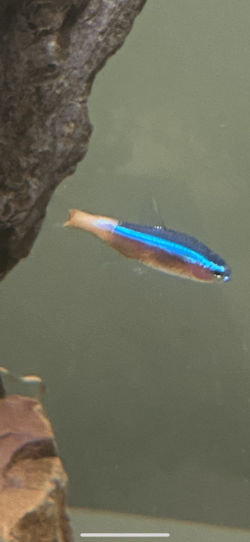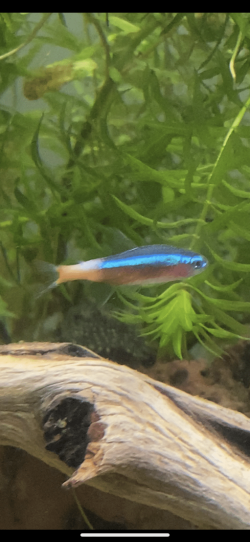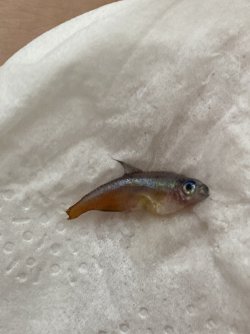Hi, I have noticed that one of my tetras is not engaging with the others and has developed a white tail. It seems to be struggling to swim, flowing with the current from my filter. I did not see this, this morning and was wondering if this is a cause of concern?
You are using an out of date browser. It may not display this or other websites correctly.
You should upgrade or use an alternative browser.
You should upgrade or use an alternative browser.
Cardinal Tetra sudden colour change
- Thread starter shae
- Start date
The April FOTM Contest Poll is open!

🏆 Click to vote! 🏆
plebian
Fish Fanatic
There is definitely something wrong. I don't think it's something that's contagious, so no worries there. Most likely, he is either dying of old age or as the result of some genetic deficiency.Hi, I have noticed that one of my tetras is not engaging with the others and has developed a white tail. It seems to be struggling to swim, flowing with the current from my filter. I did not see this, this morning and was wondering if this is a cause of concern?
It's a bacterial infection. Get the fish out now and euthanise it or quarantine it in a separate tank. Do the following and hope no more develop the same symptoms. If they do, you will need to treat the tank with antibiotics.
Wipe the inside of the glass down with a clean fish sponge. This removes the biofilm on the glass and the biofilm will contain lots of harmful bacteria, fungus, protozoans and various other microscopic life forms.
Do a 75% water change and gravel clean the substrate every day for a week. The water changes and gravel cleaning will reduce the number of disease organisms in the water and provide a cleaner environment for the fish to recover in. It also removes a lot of the gunk and this means any medication can work on treating the fish instead of being wasted killing the pathogens in the gunk.
Make sure any new water is free of chlorine/ chloramine before it is added to the tank.
Clean the filter if it hasn't been done in the last 2 weeks. However, if the filter is less than 6 weeks old, do not clean it. Wash the filter materials/ media in a bucket of tank water and re-use the media. Tip the bucket of dirty water on the garden/ lawn. Cleaning the filter means less gunk and cleaner water with fewer pathogens so any medication (if needed) will work more effectively on the fish.
Increase surface turbulence/ aeration to maximise the dissolved oxygen in the water.
Add some salt, (see directions below). If you don't want to add salt, look for something that treats bacteria and add it to the tank asap.
-------------------
SALT
You can add rock salt (often sold as aquarium salt), swimming pool salt, or any non iodised salt (sodium chloride) to the aquarium at the dose rate of 2 heaped tablespoon per 20 litres of water.
Keep the salt level like this for 2 weeks.
The salt will not affect the beneficial filter bacteria, fish, plants, shrimp or snails.
After you use salt and the fish have recovered, you do a 10% water change each day for a week using only fresh water that has been dechlorinated. Then do a 20% water change each day for a week. Then you can do bigger water changes after that. This dilutes the salt out of the tank slowly so it doesn't harm the fish.
When you do water changes while using salt, you need to treat the new water with salt before adding it to the tank. This will keep the salt level stable in the tank and minimise stress on the fish.
When you first add salt, add the salt to a small bucket of tank water and dissolve the salt. Then slowly pour the salt water into the tank near the filter outlet. Add the salt over a couple of minutes.
Wipe the inside of the glass down with a clean fish sponge. This removes the biofilm on the glass and the biofilm will contain lots of harmful bacteria, fungus, protozoans and various other microscopic life forms.
Do a 75% water change and gravel clean the substrate every day for a week. The water changes and gravel cleaning will reduce the number of disease organisms in the water and provide a cleaner environment for the fish to recover in. It also removes a lot of the gunk and this means any medication can work on treating the fish instead of being wasted killing the pathogens in the gunk.
Make sure any new water is free of chlorine/ chloramine before it is added to the tank.
Clean the filter if it hasn't been done in the last 2 weeks. However, if the filter is less than 6 weeks old, do not clean it. Wash the filter materials/ media in a bucket of tank water and re-use the media. Tip the bucket of dirty water on the garden/ lawn. Cleaning the filter means less gunk and cleaner water with fewer pathogens so any medication (if needed) will work more effectively on the fish.
Increase surface turbulence/ aeration to maximise the dissolved oxygen in the water.
Add some salt, (see directions below). If you don't want to add salt, look for something that treats bacteria and add it to the tank asap.
-------------------
SALT
You can add rock salt (often sold as aquarium salt), swimming pool salt, or any non iodised salt (sodium chloride) to the aquarium at the dose rate of 2 heaped tablespoon per 20 litres of water.
Keep the salt level like this for 2 weeks.
The salt will not affect the beneficial filter bacteria, fish, plants, shrimp or snails.
After you use salt and the fish have recovered, you do a 10% water change each day for a week using only fresh water that has been dechlorinated. Then do a 20% water change each day for a week. Then you can do bigger water changes after that. This dilutes the salt out of the tank slowly so it doesn't harm the fish.
When you do water changes while using salt, you need to treat the new water with salt before adding it to the tank. This will keep the salt level stable in the tank and minimise stress on the fish.
When you first add salt, add the salt to a small bucket of tank water and dissolve the salt. Then slowly pour the salt water into the tank near the filter outlet. Add the salt over a couple of minutes.
Hi I believe so, found it this morning sucked against the filter dead. back fins seem to have completely gone and I believe either my fish have nipped him or something has ripped open his belly. He seems to have gained back some colour however.It's a bacterial infection. Get the fish out now and euthanise it or quarantine it in a separate tank. Do the following and hope no more develop the same symptoms. If they do, you will need to treat the tank with antibiotics.
Wipe the inside of the glass down with a clean fish sponge. This removes the biofilm on the glass and the biofilm will contain lots of harmful bacteria, fungus, protozoans and various other microscopic life forms.
Do a 75% water change and gravel clean the substrate every day for a week. The water changes and gravel cleaning will reduce the number of disease organisms in the water and provide a cleaner environment for the fish to recover in. It also removes a lot of the gunk and this means any medication can work on treating the fish instead of being wasted killing the pathogens in the gunk.
Make sure any new water is free of chlorine/ chloramine before it is added to the tank.
Clean the filter if it hasn't been done in the last 2 weeks. However, if the filter is less than 6 weeks old, do not clean it. Wash the filter materials/ media in a bucket of tank water and re-use the media. Tip the bucket of dirty water on the garden/ lawn. Cleaning the filter means less gunk and cleaner water with fewer pathogens so any medication (if needed) will work more effectively on the fish.
Increase surface turbulence/ aeration to maximise the dissolved oxygen in the water.
Add some salt, (see directions below). If you don't want to add salt, look for something that treats bacteria and add it to the tank asap.
-------------------
SALT
You can add rock salt (often sold as aquarium salt), swimming pool salt, or any non iodised salt (sodium chloride) to the aquarium at the dose rate of 2 heaped tablespoon per 20 litres of water.
Keep the salt level like this for 2 weeks.
The salt will not affect the beneficial filter bacteria, fish, plants, shrimp or snails.
After you use salt and the fish have recovered, you do a 10% water change each day for a week using only fresh water that has been dechlorinated. Then do a 20% water change each day for a week. Then you can do bigger water changes after that. This dilutes the salt out of the tank slowly so it doesn't harm the fish.
When you do water changes while using salt, you need to treat the new water with salt before adding it to the tank. This will keep the salt level stable in the tank and minimise stress on the fish.
When you first add salt, add the salt to a small bucket of tank water and dissolve the salt. Then slowly pour the salt water into the tank near the filter outlet. Add the salt over a couple of minutes.
Attachments
Wipe the inside of the glass down.
Do a big water change and gravel clean the substrate.
Clean the filter if it hasn't been done in the last 2 weeks.
These things will reduce the number of disease organisms in the water and hopefully prevent any more fish developing it.
You need to monitor the fish for this and if it appears again, treat the tank or you will end up losing everything in it.
Do a big water change and gravel clean the substrate.
Clean the filter if it hasn't been done in the last 2 weeks.
These things will reduce the number of disease organisms in the water and hopefully prevent any more fish developing it.
You need to monitor the fish for this and if it appears again, treat the tank or you will end up losing everything in it.
plebian
Fish Fanatic
Given the late stage of the disease, and the fact that no other fish are displaying symptoms, the death of this fish was almost certainly not caused by bacteria. While the recommended treatment is relatively safe, assuming there are no other species in the aquarium that might be sensitive to salt, it is also relatively ineffective, even if the infection was bacterial in origin. The salt will only effect bacteria in the water column (and the filters), while the remaining fish would already have been infected.
In short, if any of the remaining fish begin to show symptoms, and the source can be indentified as bacterial (not parasitic or viral, for example), a food based medication will be necessary. If none of the remaining fish become symptomatic, then it is almost certain the symptomatic fish died a natural death, as I suggested in my initial response.
In short, if any of the remaining fish begin to show symptoms, and the source can be indentified as bacterial (not parasitic or viral, for example), a food based medication will be necessary. If none of the remaining fish become symptomatic, then it is almost certain the symptomatic fish died a natural death, as I suggested in my initial response.
Latest Discussions
- Replies
- 0
- Views
- 58
- Replies
- 13
- Views
- 130
Staff online
-
FishmanicTFF Contest Czar
Members online
Total: 579 (members: 7, guests: 572)





